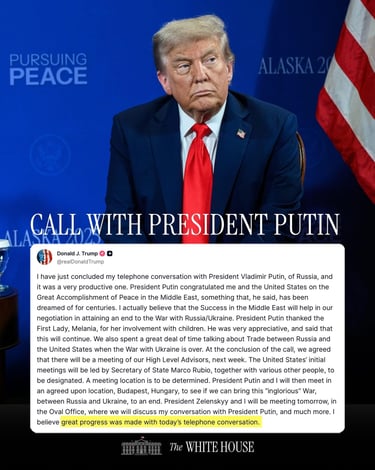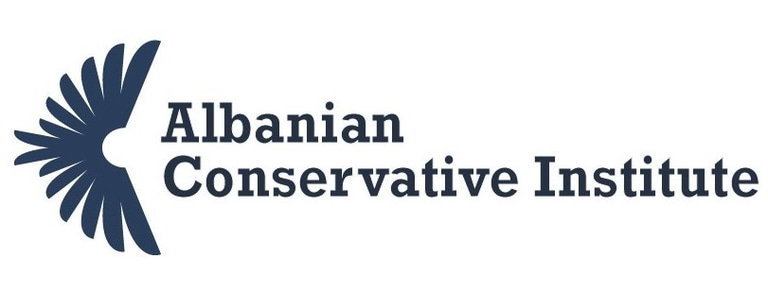Nga Akordet e Abrahamit te Marrëveshja e Alaskës: Fillimi i një Rendi të Ri Botëror
From the Abraham Accords to the Alaska Agreement: The Dawn of a New Global Order
Enri Çeno
10/17/20258 min read


Preludi i ri global – një botë në rishpërndarje fuqish
Pas më shumë se tri dekadash pas Luftës së Ftohtë, bota po hyn në një moment rishpërndarjeje gjeopolitike të ngjashme me periudhat pas luftërave botërore. Akordet e Abrahamit (2020), të ndërmjetësuara nga SHBA, ishin akti i parë konkret që sinjalizoi se politika globale po zhvendoset nga përplasja drejt balancës.
Ato nuk ishin thjesht marrëveshje paqeje mes Izraelit dhe disa shteteve arabe, por një model i ri diplomatik: paqe përmes interesave të përbashkëta strategjike, teknologjike dhe ekonomike, më shumë sesa përmes idealizmit tradicional diplomatik.
Në këtë frymë, “Marrëveshja e Alaskës” (nëse do të formësohej si koncept real), do të përfaqësonte fazën e dytë të kësaj arkitekture të re ndërkombëtare — një përpjekje për ta përfshirë Rusinë në një ekuilibër të ri, për ta nxjerrë gradualisht nga orbita kineze dhe për ta afruar me Perëndimin, në mënyrë që të shmanget krijimi i një blloku aziatik hegjemonik.
SHBA–Rusi: nga rivaliteti i epokave te nevoja për bashkëpunim strategjik
Pas më shumë se dy vitesh lufte në Ukrainë dhe sanksionesh të ashpra ekonomike, Rusia është gjetur në një varësi të thellë ekonomike dhe teknologjike ndaj Kinës.
Pekini e ka shfrytëzuar konfliktin për ta kthyer Moskën në partner të varur, duke e orientuar drejt tregjeve aziatike dhe sistemeve të pagesave alternative si CIPS, në vend të SWIFT-it perëndimor.
Kjo varësi ka krijuar një asimetrikë të re gjeopolitike, që e ka bërë Rusinë më të dobët dhe Kinën më të guximshme.
Nga ana tjetër, SHBA po përballet me sfidën më të madhe strategjike të shekullit XXI: si të frenojë ngritjen e Kinës pa e shtyrë Rusinë plotësisht në krahët e saj.
Një marrëveshje e re – e ngjashme në frymë me Akordet e Abrahamit – por këtë herë midis Washingtonit dhe Moskës, do të kishte synimin jo të krijojë miqësi, por të rindërtojë një ekuilibër të domosdoshëm.
Akordet e Alaskës – një metaforë për ngrirjen e një lufte dhe shkrirjen e një epoke
Nëse “Akordet e Abrahamit” simbolizuan afrimin mes Lindjes dhe Izraelit, Akordet e Alaskës do të përfaqësonin afrimin midis dy poleve të mëdha veriore – SHBA dhe Rusisë – në territorin simbolik të Alaskës, një zonë që historikisht lidhte fizikisht dy botë që dikur ishin një hapësirë: Amerikën dhe Euroazinë.
Një marrëveshje e tillë do të kishte disa qëllime kryesore:
Ngrirja e konfliktit në Ukrainë, me një zgjidhje që ruan integritetin territorial të shtetit, por që parashikon garanci të përbashkëta për sigurinë në kufijtë lindorë.
Rikthimi i Rusisë në arkitekturën e tregtisë ndërkombëtare, nën kushte të reja kontrolli, për të balancuar ndikimin kinez.
Krijimi i një “këshilli të ri gjeoteknologjik” ku SHBA, BE dhe Rusia të bashkëpunojnë për kontrollin e zhvillimit të inteligjencës artificiale, energjisë bërthamore, dhe burimeve kritike natyrore (nikel, litium, uranium).
Riformësimi i sistemit financiar global, me ndërtimin e një standardi të ri dixhital të pagesave ndërkombëtare (një “Bretton Woods 2.0”) që do të përfshinte edhe monedhat dixhitale sovrane.
Balanca e madhe: Kina në qendër të dilemës
Për Kinën, një marrëveshje e tillë do të përbënte sfidën më serioze strategjike që nga themelimi i Republikës Popullore më 1949.
Nëse Moska afrohet me Perëndimin, Pekini humbet aleatin më të madh gjeostrategjik në Euroazi dhe përballet me një rrethim të ri – ekonomik, teknologjik dhe ushtarak – nga një bosht SHBA–BE–Rusi.
Për këtë arsye, çdo përpjekje për “Akordet e Alaskës” do të përballet me kundërshtime të ashpra nga Kina. Pekini do të tentojë të intensifikojë bashkëpunimin ekonomik, të rrisë ndikimin në BRICS dhe të zgjerojë përdorimin e juanit në tregtinë ndërkombëtare, për të mos lejuar që një rend i ri i udhëhequr nga Perëndimi të rikthejë dominimin e dollarit.
Dimensioni teknologjik – revolucioni i katërt industrial si front i paqes dhe konfliktit
Në sfondin e kësaj loje të madhe, po ndodh revolucioni më i rëndësishëm industrial në historinë e njerëzimit – ai i inteligjencës artificiale, ku epërsia teknologjike është e barabartë me epërsinë gjeopolitike.
SHBA dominon në AI përmes kompanive si OpenAI, Google DeepMind dhe Anthropic;
Kina po përpiqet të ndërtojë një model të vetëqëndrueshëm nën kontroll shtetëror;
Rusia, e izoluar, kërkon partnerë për të hyrë në këtë garë.
Një akord global teknologjik, që do të përfshinte rregullat e sigurisë së AI-së, kontrollin e teknologjive duale (civile-ushtarake) dhe mbikëqyrjen etike të sistemeve autonome, do të ishte pjesë e “Paktit të Alaskës” – një mënyrë për ta kthyer konkurrencën në bashkëpunim.
Në këtë kuptim, inteligjenca artificiale nuk është vetëm mjet zhvillimi — është mjeti i paqes së re strategjike.
Rendi i ri financiar dhe energjetik – drejt një bote multipolare të menaxhuar
Në planin financiar, çdo marrëveshje e madhe SHBA–Rusi do të synojë të stabilizojë tregjet e energjisë dhe të zhvendosë dominimin nga karburantet drejt energjisë së pastër, por pa prishur ekuilibrat e ekonomive eksportuese.
Në planin monetar, pritet të lindë një arkitekturë e re digjitale globale — një sistem pagesash të bazuar në monedha dixhitale të bankave qendrore (CBDC), që mund të zëvendësojë gradualisht rolin e SWIFT-it dhe të balancojë ndikimin e BRICS.
Në këtë rend të ri, SHBA do të ruajë epërsinë teknologjike, BE do të mbajë rolin e stabilizuesit institucional, Rusia do të kërkojë garanci sigurie dhe tregje energjie, ndërsa Kina do të duhet të përshtatet me realitetin e një bote që nuk pranon më dominim të vetëm.
“Paqja e Ftohtë” si forma e re e stabilitetit global
Nëse “Akordet e Abrahamit” sollën paqe në Lindjen e Mesme, Akordet e Alaskës mund të sjellin një “paqë të ftohtë” në Euroazi.
Jo në kuptimin e mungesës së tensioneve, por si një marrëveshje për të menaxhuar rivalitetin dhe për ta kthyer garën në bashkëjetesë strategjike.
Në një botë ku inteligjenca artificiale, ekonomia digjitale dhe energjia e pastër po përcaktojnë fuqinë, paqja nuk është më çështje ideologjie – por algoritmi, interesi dhe stabiliteti.
Në fund të fundit, çdo rend i ri botëror lind jo nga fitoret ushtarake, por nga marrëveshjet që arrijnë të menaxhojnë frikën dhe ambicien njëherazi.
Dhe në këtë kuptim, “Marrëveshja e Alaskës” – si ide, si metaforë, si vizion – mund të jetë akordi i shekullit XXI.
A New Global Prelude – A World in Strategic Redistribution
More than three decades after the end of the Cold War, the world is once again entering a phase of geopolitical redistribution, similar to the periods that followed the great world wars.
The Abraham Accords (2020), brokered by the United States, were the first concrete signal that global politics is shifting from confrontation to equilibrium.
They were not merely peace agreements between Israel and several Arab states, but rather a new diplomatic model: peace through shared strategic, technological, and economic interests—more pragmatic than the traditional idealism of diplomacy.
In that same spirit, the idea of an “Alaska Agreement” would represent the second phase of this emerging global architecture—an attempt to reintegrate Russia into a new balance of power, gradually distancing it from Chinese influence, and realigning it closer to the West.
The ultimate goal: to prevent the consolidation of a hegemonic Asian bloc and to lay the groundwork for a managed multipolar world order.
U.S.–Russia: From Enduring Rivalry to Strategic Necessity
After more than two years of war in Ukraine and sweeping economic sanctions, Russia has found itself in deep economic and technological dependence on China.
Beijing has leveraged the conflict to turn Moscow into a junior strategic partner, redirecting its exports to Asian markets and integrating it into China’s alternative payment systems like CIPS instead of the Western SWIFT network.
This dependence has created a new geopolitical asymmetry—a weaker Russia and a more assertive China.
Meanwhile, the United States faces the greatest strategic dilemma of the 21st century: how to contain China’s rise without pushing Russia fully into its orbit.
A new accord—akin in spirit to the Abraham Accords but this time between Washington and Moscow—would not aim to create friendship but rather to rebuild a necessary equilibrium.
The “Alaska Accords” – Freezing a War, Thawing an Era
If the Abraham Accords symbolized rapprochement between Israel and the Arab world, the “Alaska Accords” would represent rapprochement between the two great northern powers—the U.S. and Russia—linked symbolically through Alaska, a region that once physically connected the two continents of America and Eurasia.
Such an accord would have several core objectives:
Freeze the conflict in Ukraine through an arrangement preserving the country’s sovereignty but incorporating joint security guarantees for Eastern Europe.
Reintegrate Russia into global trade structures, under new transparency and compliance mechanisms, balancing Beijing’s growing influence.
Establish a “Geotechnological Council”—a trilateral framework between the U.S., EU, and Russia to oversee collaboration in artificial intelligence, nuclear energy, and critical raw materials such as lithium, nickel, and uranium.
Reform the international financial system, paving the way for a new digital monetary framework—a Bretton Woods 2.0—that would integrate sovereign digital currencies (CBDCs) under global oversight.
The China Dilemma – Between Containment and Adaptation
For China, such an agreement would represent the most serious strategic challenge since the founding of the People’s Republic in 1949.
If Moscow tilts back toward the West, Beijing would lose its largest strategic partner in Eurasia, facing a new encirclement—economic, technological, and military—by a U.S.–EU–Russia axis.
Consequently, Beijing would likely counter such a move by intensifying its economic engagement with Russia, expanding the BRICS framework, and internationalizing the yuan to prevent a renewed dollar-dominated order.
A potential “Alaska framework” would thus redraw the balance of global influence, creating a triangular system of competitive cooperation rather than a binary Cold War structure.
The Technological Dimension – The Fourth Industrial Revolution as Both Weapon and Peace Mechanism
Behind this grand geopolitical chessboard lies the most transformative industrial revolution in human history: the age of artificial intelligence.
Here, technological supremacy equates directly with geopolitical power.
The United States currently dominates AI innovation through companies like OpenAI, Google DeepMind, and Anthropic.
China is developing a state-controlled AI ecosystem aimed at autonomy from Western systems.
Russia, isolated from both, is seeking strategic partners to remain relevant in this technological race.
A global technological accord—defining rules for AI safety, dual-use technologies, and autonomous systems—would likely form a key pillar of the “Alaska framework.”
In that sense, AI is not merely a tool of innovation—it is the new instrument of peace through parity.
Financial and Energy Realignment – Toward a Managed Multipolar World
In financial and energy terms, any U.S.–Russia rapprochement would aim to stabilize global energy markets and manage the transition from fossil fuels to clean energy without destabilizing exporting economies.
Monetarily, the world is moving toward a digital financial architecture—one where central bank digital currencies (CBDCs) gradually replace traditional systems like SWIFT and allow for a more balanced global liquidity network.
In such a system, the U.S. would retain technological leadership, Europe would serve as the institutional stabilizer, Russia would seek energy and security guarantees, and China would be compelled to adapt to a shared-governance model rather than dominance.
The “Cold Peace” as the New Form of Global Stability
If the Abraham Accords brought peace to the Middle East, the Alaska Accords could bring a “Cold Peace” to Eurasia.
Not peace in the idealistic sense, but a structured coexistence—a framework for managing rivalry rather than eliminating it.
In a world defined by artificial intelligence, digital economies, and clean energy, peace is no longer a matter of ideology—it is a function of algorithms, interests, and interdependence.
Ultimately, every new world order emerges not from military victories but from agreements that can manage both fear and ambition simultaneously.
In that light, the “Alaska Agreement”—as concept, as metaphor, as vision—may well become the defining accord of the 21st century.
